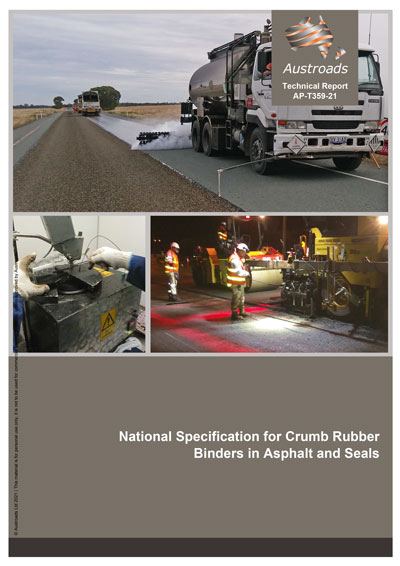Pavement

- Publication no: AP-T359-21
- ISBN: 978-1-922382-88-7
- Published: 8 September 2021
- PDF (free) Download
Crumb rubber binders have been used to construct sprayed seals in Australia for many decades but have not been utilised in asphalt in the past. Due to the lack of crumb rubber binder grades in the Australian national polymer modified binder (PMB) specification (ATS 3110), two Austroads jurisdictions have conducted research to develop specifications for crumb rubber binders that are suitable for use in asphalt. These specifications have been based on US testing protocols rather than ATS 3110-specified tests.
This report describes experimental work conducted to propose ATS 3110-related specification limits for a crumb rubber binder which is representative of the type of binder trialled by Austroads jurisdictions in asphalt, as well as a blend of C170 bitumen and 9% w/w crumb rubber (for use in sprayed sealing applications). The report also includes the results of asphalt performance tests which were performed to determine how the level of crumb rubber in a binder affected asphalt mix performance.
The report includes literature reviews into a number of crumb rubber related areas and the results of a survey of Australian crumb rubber manufacturers into the properties of the material they produce.
Watch a webinar with lead author Robert Urquhart.
- Summary
- 1. Introduction
- 1.1 Background
- 1.2 Purpose
- 1.3 Scope
- 1.4 Methodology
- 2. Benefits and Impediments of Using Crumb Rubber in Road Construction
- 2.1 Benefits
- 2.1.1 Environmental Benefits
- 2.1.2 Performance Benefits in Sprayed Seals and Asphalt
- 2.2 Impediments
- 2.2.1 Crumb Rubber Supply
- 2.2.2 Emissions
- 2.2.3 Crumb Rubber Binder Segregation and Degradation
- 2.2.4 Road Construction Costs
- 2.3 Summary
- 2.1 Benefits
- 3. Previous Australian Research/trials into the Use of Crumb Rubber Binders in Asphalt
- 3.1 Review of National Asset Centre of Excellence (NACOE) Projects on Crumb Rubber Binders
- 3.1.1 Development of Queensland Specifications to Promote Crumb Rubber Use
- 3.1.2 NACOE Studies of Crumb Rubber Modified Binder Properties
- 3.1.3 Construction of Asphalt Demonstration Sites Using Crumb Rubber Binders
- 3.1.4 Development of Queensland Crumb Rubber Modified Binder Specifications for Use in Asphalt
- 3.2 Review of Western Australian Road Research and Innovation Program (WARRIP) Projects on Crumb Rubber Binders
- 3.2.1 WARRIP Studies into the Use of Crumb Rubber Binders in Gap Graded Asphalt (GGA)
- 3.3 Department of Transport Victoria (DoT Vic) Trials of Crumb Rubber Asphalt
- 3.4 Local Government Trials in South Australia
- 3.5 Discussion/Summary
- 3.1 Review of National Asset Centre of Excellence (NACOE) Projects on Crumb Rubber Binders
- 4. Australian and International Specifications for Crumb Rubber Used in Road Construction
- 4.1 Australian Specification Requirements for Crumb Rubber
- 4.1.1 Comparisons with the Austroads Crumb Rubber Specification (ATS 3110)
- 4.1.2 Comparison of Australian Test Property Requirements for Crumb Rubber
- 4.1.3 Summary
- 4.2 International Crumb Rubber Specifications
- 4.2.1 Comparisons with the Austroads Crumb Rubber Specification (ATS 3110)
- 4.2.2 Comparison of International Test Property Requirements for Crumb Rubber
- 4.2.3 Summary
- 4.1 Australian Specification Requirements for Crumb Rubber
- 5. Effects of Crumb Rubber Characteristics on Binder and Asphalt Mix Properties
- 5.1 Effects of Crumb Rubber Characteristics on Binder Properties
- 5.1.1 Oliver (1981)
- 5.1.2 Khalili, Jadidi and Amirkhanian (2019)
- 5.1.3 Putman and Amirkhanian (2006)
- 5.1.4 Wang et al. (2012)
- 5.1.5 Singh, Ashish and Jagadeesh (2018)
- 5.1.6 Dantas-Neto et al. (2006)
- 5.2 Effects of Crumb Rubber Characteristics on Asphalt Properties
- 5.2.1 Wong and Wong (2007)
- 5.2.2 Xiao et al. (2009)
- 5.3 Discussion
- 5.3.1 Binder Properties
- 5.3.2 Asphalt Properties
- 5.4 Summary
- 5.1 Effects of Crumb Rubber Characteristics on Binder Properties
- 6. Survey of Crumb Rubber Properties Targeted by Australian Suppliers
- 6.1 Discussion/Summary
- 7. Binder Test Results
- 7.1 Introduction
- 7.2 Experimental Design
- 7.2.1 Binder Materials
- 7.2.2 Crumb Rubber Binder Sample Manufacture
- 7.2.3 Binder Test Procedures
- 7.3 Binders Containing C170 Bitumen and Different Levels of Crumb Rubber
- 7.4 Formulation of a Binder which Meets ATS 3110-specified Properties for S45R
- 7.5 Further Work Investigating the Properties of 20% w/w Crumb Rubber Binders
- 7.6 Test Results for US Crumb Rubber Binder Samples
- 7.7 Comparisons Between ATS 3110 and US Test Results
- 7.8 Summary
- 8. Determination of ATS 3110-specified Properties for Different Crumb Rubber Binders
- 8.1 Introduction
- 8.2 Fitted Test Results for Laboratory Blends
- 8.3 Specification Limit Determinations for Different Test Parameters
- 8.3.1 Viscosity at 165 C
- 8.3.2 Torsional Recovery at 25 C, Softening Point and Consistency 6% at 60 C
- 8.3.3 Stress Ratio at 10 C
- 8.3.4 Compressive Limit at 70 C and Segregation
- 8.3.5 Flash Point and Loss on Heating/Mass Change
- 8.4 Crumb Rubber Binder Properties Presented to Austroads BSTG
- 8.5 Proposed ATS 3110 Specified Properties for Crumb Rubber Binders
- 9. Asphalt Test Results
- 9.1 Introduction
- 9.2 Experimental Design
- 9.2.1 Asphalt Mix Design
- 9.2.2 Asphalt Specimen Preparation and Testing
- 9.3 PMB-related Test Results Obtained for the C320 Bitumen and A15E Binder Samples and NACOE Project Binders
- 9.4 Asphalt Test Results
- 9.4.1 Volumetric Tests
- 9.4.2 Resilient Modulus Tests
- 9.4.3 Hamburg Wheel Tracking Tests
- 9.4.4 Asphalt Fatigue Tests
- 9.5 Summary
- 10. Summary and Conclusions
- References
- Appendix A Plots of Binder Test Properties Versus Crumb Rubber Binder Composition Not Included in the Main Body of the Report
- A.1 Blends Containing C170 Bitumen and Different Levels of Crumb Rubber
- A.2 Blends Prepared During Preparation of a Compliant S45R Grade Crumb Rubber Binder
- A.3 Blends Containing 20% w/w Crumb Rubber Prepared at 210 C
- Appendix B Hamburg Wheel Tracking Results Obtained During the Study
- Appendix C Individual Specimen Results Obtained in Asphalt Fatigue Tests
